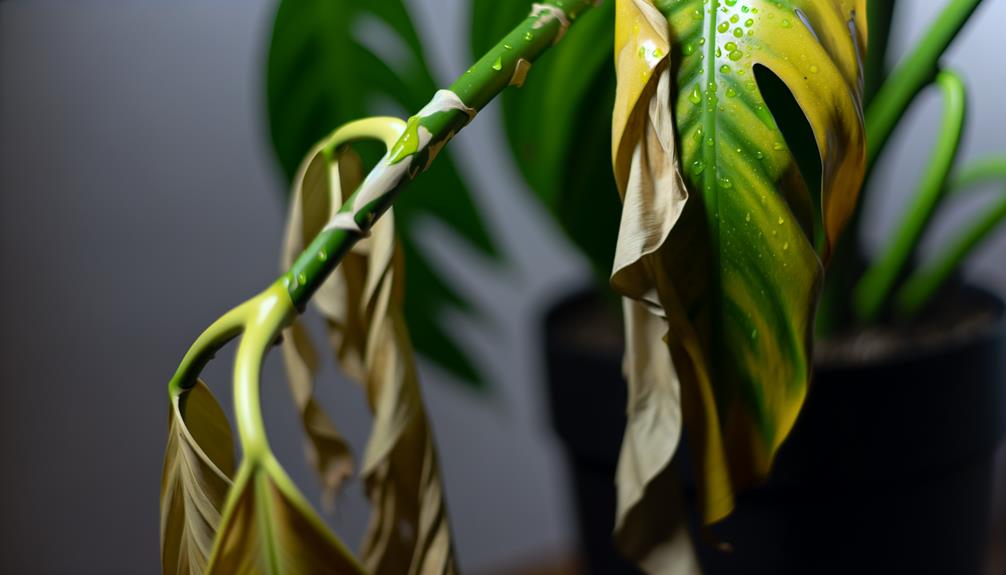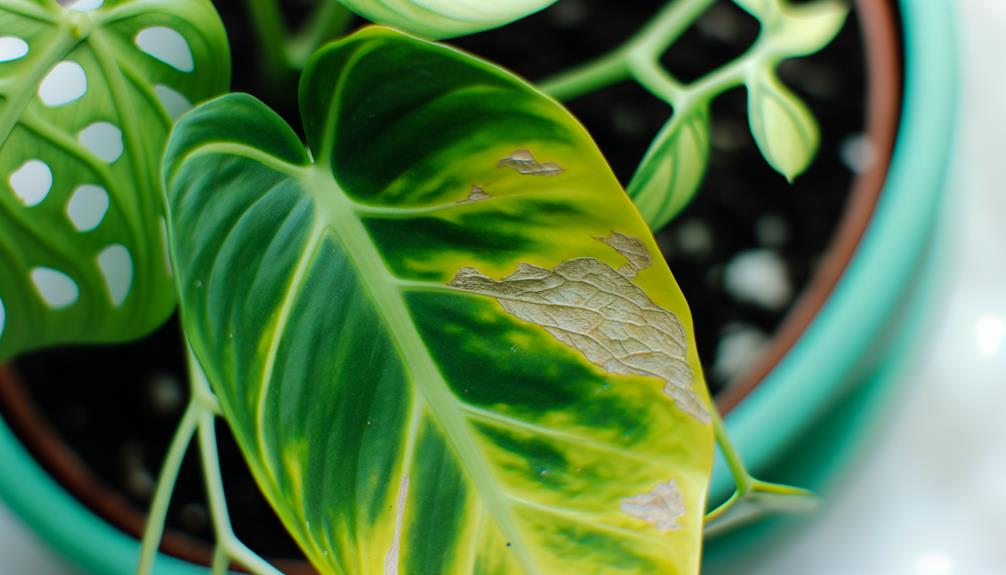Monstera Minima Leaves Turning Yellow: Causes and Solutions!
Your Monstera Minima’s leaves turning yellow could be due to improper watering. Overwatering leads to root rot, causing nutrient deficiency and chlorosis.
Make sure the pot has proper drainage and let the top inch of soil dry out between waterings. On the other hand, underwatering results in root dehydration, showing symptoms like wilting and leaf curling.
Maintain a balanced watering schedule, and consistently check soil moisture. Additionally, ensure sufficient indirect sunlight and stable temperatures between 65-75°F (18-24°C).
Avoid sudden light and temperature changes. By addressing these factors, you’ll improve your plant’s health and learn more about best care practices.

Key Takeaways
- Overwatering can cause root rot and lead to yellowing leaves.
- Insufficient soil moisture can result in yellowing leaves and impaired photosynthesis.
- Root dehydration symptoms include yellowing leaves, wilting, and leaf curling.
- Inadequate light or sudden light changes can cause chlorosis, resulting in yellow leaves.
- Maintain stable temperature and humidity to prevent environmental stress and leaf yellowing.
Overwatering Issues

When you overwater your Monstera Minima, the excess moisture in the soil can lead to root rot, which is a primary cause of yellowing leaves.
Root rot occurs when the roots are deprived of oxygen, causing them to decay and become unable to absorb essential nutrients. This nutrient deficiency manifests as chlorosis, or yellowing, in the leaves.
To avoid this, make sure your plant’s pot has adequate drainage and that you allow the top inch of soil to dry out between waterings. Monitoring soil moisture with a moisture meter can provide precise data to prevent overwatering.
Regularly examining the roots for signs of rot—such as dark, mushy roots—can help you address issues early, maintaining your Monstera Minima’s health.
Underwatering Effects
You might notice that soil moisture deficiency leads to root dehydration, which in turn manifests as yellowing leaves on your Monstera Minima.
When roots can’t access enough water, they fail to transport essential nutrients, causing visible stress in the plant.
Examining the soil and monitoring its moisture levels can help you identify if underwatering is the culprit.
Soil Moisture Deficiency
Insufficient soil moisture is a primary cause of yellowing leaves in Monstera Minima, leading to cellular dehydration and impaired photosynthesis. When the soil lacks adequate moisture, the plant’s roots can’t absorb necessary water and nutrients. This deficiency disrupts crucial physiological processes, reducing chlorophyll synthesis and causing leaves to turn yellow.
You should monitor soil moisture levels consistently, ensuring the top inch of soil remains slightly damp. Utilize a moisture meter for accuracy. Avoid letting the soil dry out completely between waterings, as this exacerbates moisture stress.
To mitigate this issue, maintain a balanced watering schedule, and consider using well-draining soil to prevent waterlogging while retaining sufficient moisture. Regular observation and adjustment are key to preventing yellowing leaves due to underwatering.
Root Dehydration Symptoms
Root dehydration in Monstera Minima appears through distinct symptoms like wilting, leaf curling, and yellowing, making it crucial to address watering practices promptly.
When roots lack sufficient moisture, they can’t transport essential nutrients effectively, leading to stress responses in the plant. You’ll notice leaves start to droop and curl as they try to conserve water. Eventually, the plant’s overall health diminishes, resulting in yellowing leaves. This yellowing primarily begins at the leaf tips and edges before spreading inward.
To mitigate root dehydration, maintain consistent watering schedules. Check soil moisture using your finger or a moisture meter to sustain ideal hydration. Avoid letting the soil dry out completely to prevent these harmful effects on your Monstera Minima.
Leaf Color Changes
As root dehydration sets in, Monstera Minima leaves often exhibit color changes, with yellowing being a predominant sign of underwatering. When your plant doesn’t receive enough water, its cellular processes slow down, causing chlorophyll degradation and subsequent yellowing.
To diagnose underwatering, look for:
- Leaf Curling: Yellow leaves may curl at the edges, indicating insufficient moisture.
- Crisp Texture: Dry, brittle leaves often accompany yellowing, showing prolonged water deficiency.
- Soil Condition: Check if the soil is dry beyond the top inch, confirming inadequate hydration.
Identifying these signs guarantees you can adjust watering practices promptly.
Always assess the plant’s environment, as factors like humidity and temperature can exacerbate dehydration.
Being mindful of these signs can help maintain your Monstera Minima’s vibrant health.
Nutrient Deficiency

A common cause of yellowing leaves in Monstera Minima is a nutrient deficiency, often resulting from inadequate essential minerals such as nitrogen, potassium, or magnesium. When your plant lacks these nutrients, you’ll notice specific symptoms indicating which element is deficient.
Nitrogen deficiency often causes uniform yellowing of older leaves, while potassium deficiency results in leaf edges turning yellow. Magnesium deficiency generally shows as yellowing between the leaf veins.
Here’s a detailed table summarizing these deficiencies:
| Nutrient | Symptoms | Solution |
|---|---|---|
| Nitrogen | Uniform yellowing of older leaves | Use a balanced fertilizer |
| Potassium | Yellowing leaf edges | Apply potassium supplement |
| Magnesium | Yellowing between leaf veins | Use Epsom salt (magnesium sulfate) |
Pests and Diseases
Yellowing leaves in Monstera Minima can also indicate the presence of pests and diseases, which often exacerbate the plant’s struggle for nutrients. Identifying and addressing these issues is essential for the plant’s health.
- Spider Mites: These tiny arachnids suck sap from the leaves, causing yellow spots and a stippled appearance. Use insecticidal soap or neem oil for treatment.
- Root Rot: Caused by overwatering and poor drainage, root rot leads to yellowing leaves. Ensure well-draining soil and moderate watering to prevent this fungal disease.
- Scale Insects: These pests attach themselves to stems and leaves, draining nutrients. Remove them manually or use horticultural oil.
Regular monitoring and timely intervention can help you manage these problems effectively.
Lighting Problems

Lighting issues often cause Monstera Minima leaves to turn yellow. If your plant receives insufficient natural light, its photosynthesis process will be impaired.
Conversely, excessive direct sunlight can scorch the leaves, while inconsistent light exposure disrupts the plant’s growth cycle.
Insufficient Natural Light
Insufficient natural light often causes Monstera Minima leaves to turn yellow, as inadequate lighting disrupts the plant’s photosynthesis process. When your Monstera Minima doesn’t receive enough light, it can’t produce the chlorophyll it needs, leading to yellowing leaves.
To address this issue, consider the following strategies:
- Place Near Bright, Indirect Light: Position your Monstera Minima near windows that receive abundant indirect sunlight, such as north-facing or east-facing windows.
- Use Grow Lights: If natural light is lacking, supplement with full-spectrum grow lights to simulate natural sunlight.
- Regularly Rotate the Plant: Rotate your plant every few weeks to ensure all sides receive equal light exposure, fostering uniform growth.
Excessive Direct Sunlight
Too much direct sunlight can scorch Monstera Minima leaves, causing them to turn yellow and develop brown spots. When exposed to excessive sunlight, the chlorophyll in the leaves breaks down, leading to chlorosis. This condition manifests as yellow discoloration.
Additionally, UV radiation can damage cellular structures, resulting in necrotic patches that appear brown. To prevent this, place your Monstera Minima in bright, indirect light. East or north-facing windows work best, as they provide ample light without harsh rays. Consider using sheer curtains to diffuse sunlight if necessary.
Regularly inspect leaves for signs of sunburn and adjust the plant’s location accordingly. Monitoring light levels with a lux meter can also ensure ideal lighting conditions for healthy foliage.
Inconsistent Light Exposure
Inconsistent light exposure can stress your Monstera Minima, leading to yellowing leaves as the plant struggles to adapt to fluctuating conditions. When your plant experiences varying light levels, it can’t efficiently perform photosynthesis, resulting in weakened health and discolored foliage.
Guarantee a stable environment by:
- Providing Consistent Light: Place your plant in an area with indirect sunlight for at least six hours daily.
- Avoiding Dark Spots: Sudden shifts from bright to dark areas can shock the plant. Keep it in a well-lit location.
- Using Grow Lights: Supplement natural light with grow lights during shorter days or in low-light homes to maintain uniform exposure.
Maintaining consistent lighting helps your Monstera Minima thrive without the stress that causes yellowing leaves.
Temperature Stress
Temperature stress can significantly affect Monstera Minima, often causing the leaves to turn yellow due to the plant’s sensitivity to non-ideal temperature ranges.
When temperatures fall below 60°F (15.5°C) or rise above 85°F (29.4°C), the plant’s cellular processes become disrupted. This disruption can lead to chlorosis, a condition where the leaves lose chlorophyll, turning yellow as a result.
To prevent this, maintain a stable indoor temperature, ideally between 65-75°F (18-24°C). Sudden temperature fluctuations, drafts, or placing the plant near heating or cooling vents can exacerbate stress.
Monitoring room temperature with a reliable thermometer and adjusting the plant’s location as needed can mitigate temperature-induced yellowing. Understanding and controlling these aspects is vital for your Monstera Minima’s health.
Conclusion
To sum up, your Monstera minima’s yellowing leaves can result from overwatering, underwatering, nutrient deficiencies, pests, diseases, lighting issues, or temperature stress. Addressing these factors promptly is vital.
Remember, ‘an ounce of prevention is better than a pound of cure.’ Pay close attention to watering habits, nutrient levels, and environmental conditions to keep your plant thriving.
Regular monitoring and adjustments based on evidence can guarantee your Monstera minima remains healthy and vibrant.






